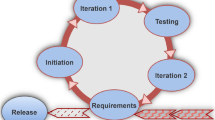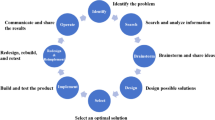Abstract
The application of content only through lectures in an expository format may not be sufficient for the teaching of software engineering in this new era. Creating software products that take the user experience (UX) into account as an essential requirement in the software development process is a necessary activity for all information technology (IT) professionals looking to build quality products. Currently, there are few initiatives that address the insertion of innovative techniques in the curriculum of undergraduate IT courses during the training of students. Design sprint (DS) in conjunction with project-based learning (PBL) provides an effective method to achieve the quality of software products when using UX techniques and creativity. One of the key features of PBL is the ability to generate artifacts with your application to solve real and non-trivial problems. This paper presents a systematic literature review (SLR) to investigate the hypothesis that joining the DS concepts with PBL identifies the user experience as one of the main attributes of quality and authenticity to be achieved in the software development projects. The objective of the SLR is to analyze how the PBL units that produce authentic software are executed. Furthermore, two case studies are reported that explore how DS behaves in a reduced number of classes when it is desired to generate a functional prototype that will be developed in a PBL unit. As a result of the SLR, it has been identified that Scrum is the software development process most used in PBL units that generate authentic software. The identified works report that the students are usually divided into groups of 2–5 people during the activities and the monitors play an important role in the quality of the software produced. The result of the case study indicates that the limited time for PBL conduction was a complicating factor in this adaptation and that students feel that their own learning and participation are positive in DS-based classes, as well as that DS provides insights that may be useful in a PBL context.







Similar content being viewed by others
References
Abler R, Coyle E, Kiopa A, Melkers J (2011) Team-based software/system development in a vertically-integrated project-based course. Proceedings—frontiers in education conference, FIE, pp T3F-1–T3F-7
Adderley K et al (1975) Project methods in higher education, vol 24. Society for research into higher education
Aibin M, Hunter A (2018) On faculty supervision in industry projects. Western Canadian Conference on Computing Education, pp 1–5
Albano G, Pierri A (2017) Digital storytelling in mathematics: a competence-based methodology. J Ambient Intell Hum Computing 8(2):301–312
Alhammad MM, Moreno AM (2018) Gamification in software engineering: a systematic mapping. J Syst Softw
Asif M, Hussain W, Solanki H, Sohaib O, Dhaliwa N (2018) Integrating design thinking into extreme programming. J Ambient Intell Hum Computing
Banfield R, Lombardo CT, Wax T (2015) Design sprint: a practical guidebook for building great digital products. O’Reilly Media, Inc
Bender W N (2012) Project-based learning: Differentiating instruction for the 21st century. Corwin Press
Bergmann J, Sams A(2014) Flipped learning: gateway to student engagement. Int Soc Technol Educ
Bernhardt J, Peña-Rios A, Wang M, White K, Callaghan V (2017) Augmented reality in education and training: pedagogical approaches and illustrative case studies. J Ambient Intell Hum Computing 9(5):1391–1402
Biolchini J, Mian PG, Natali ACC, Travassos GH (2005) Systematic review in software engineering. Syst Eng Computer Sci Depart COPPE/UFRJ Tech Rep ES 679(05):45
Blumenfeld PC, Soloway E, Marx RW, Krajcik JS, Guzdial M, Palincsar A (1991) Motivating project-based learning: sustaining the doing, supporting the learning. Educ Psychol 26(3–4):369–398
Brown T (2009) Change by design: how design thinking transforms organizations and inspires innovation, 1st edn. Harper Collins, New York
Cadenas JT, Rodríguez R, Omaña M (2014) Conceptualizing a didactics experience: mini-project software development. Proceedings of the 2014 Latin American Computing Conference, CLEI 2014
Canedo ED, da Costa RP (2018a) Methods and metrics for estimating and planning agile software projects. Compl Res
Canedo ED, da Costa RP (2018b) The use of design thinking in agile software requirements survey: a case study. In: Design, user experience, and usability: theory and practice—7th international conference, DUXU 2018, held as part of HCI International 2018, Las Vegas, NV, USA, July 15–20, 2018, Proceedings, Part I, pp 642–657
Conference TS (2018) Case studies: examples of different types of sprints
Courtney J (2018) The design sprint 2.0: what is it and what does it look like?
de Freitas SAA, Lacerda ART, Calado PMRO, Lima TS, Canedo ED (2017) Gamification in education: a methodology to identify student’s profile. In: 2017 IEEE frontiers in education conference, FIE 2017, Indianapolis, IN, USA, October 18–21, 2017, pp 1–8
de Salles Canfield D, Moreira M, Bernardes S (2017) Brazilian design thinking: a systematic literature review of theses and dissertations. Estudos em Design 25(2)
Detmer R, Li C, Dong Z, Hankins J (2010) Incorporating real-world projects in teaching computer science courses. Proceedings of the 48th annual southeast regional conference, pp 24:1–24:6
Dolog P, Thomsen LL, Thomsen B (2016) Assessing problem-based learning in a software engineering curriculum using Bloom’s taxonomy and the IEEE software engineering body of knowledge. ACM Trans Computing Educ 16(3):1–41
Dorst K (2011) The core of ’design thinking’ and its application. Design Stud 32(6):521–532
Engberts F, Borgman H (2018) The agile UX development lifecycle: combining formative usability and agile methods. In: Proceedings of the 51th Hawaii international conference on system sciences, Honolulu, HI. HICSS, pp 1611–1621
Fagerholm F, Hellas A, Luukkainen M, Kyllönen K, Yaman S, Mäenpää H (2018) Designing and implementing an environment for software start-up education: patterns and anti-patterns. J Syst Softw 146:1–13
Fioravanti ML, Sena B, Paschoal LN, Silva LR, Allian AP, Nakagawa EY, Souza SRS, Isotani S, Barbosa EF (2018) Integrating project based learning and project management for software engineering teaching: an experience report. In: Proceedings of the 49th ACM technical symposium on computer science education, number Icmc in 1, pp 806–811
Standardization (ISO) IO (2005) ISO/IEC 25000:2005, software engineering—software product quality requirements and evaluation (square). Technical report, ISO
Foster D, Gilardi F, Martin P, Song W, Towey D, White A (2018) Students as co-producers in a multidisciplinary software engineering project: addressing cultural distance and cross-cohort handover. Teachers Teaching 24(7):840–853
Frand JL (2000) The information age mindset: changes in students and implications for higher education. EDUCAUSE Rev 35:15–24
Freitas SAA, Lacerda AR, Calado PM, Lima TS, Canedo ED (2017) Gamification in education: a methodology to identify student’s profile. In: Frontiers in education conference (FIE). IEEE, pp 1–8
Hassenzahl M, Tractinsky N (2006) User experience—a research agenda. Behav Inf Technol 25(2):91–97
Helle L, Tynjälä P, Olkinuora E (2006) Project-based learning in post-secondary education theory, practice and rubber sling shots. Higher Educ 51(2):287–314
Ilkan M, Amca H, Iscioglu E (2010) Grooming IT students for industry through industrial training and graduation project work. Inf Int Interdiscip J 13(4):1219–1242
Intayoad W (2014) PBL framework for enhancing software development skills: an empirical study for information technology students. Wireless Personal Commun 76(3):419–433
Jones BF, Rasmussen CM, Moffitt MC (1997)Real-life problem solving: a collaborative approach to interdisciplinary learning. American Psychological Association
Karabulut-Ilgu A, Jaramillo Cherrez N, Jahren CT (2018) A systematic review of research on the flipped learning method in engineering education. Br J Educ Technol 49(3):398–411
Kilamo T, Hammouda I, Chatti MA (2012) Teaching collaborative software development: a case study. Proceedings—international conference on software engineering, pp 1165–1174
Kitchenham B (2004) Procedures for performing systematic reviews. Keele University, Keele, 33(TR/SE-0401), p 28
Kizaki S, Tahara Y, Ohsuga A (2014) Software development PBL focusing on communication using scrum. Proceedings—2014 IIAI 3rd international conference on advanced applied informatics, IIAI-AAI 2014, pp 662–669
Knapp J, Zeratsky J, Kowitz B (2016) Sprint: Hhw to solve big problems and test new ideas in just 5 days. Simon and Schuster, New York
Leavy B (2010) Design thinking a new mental model of value innovation. Strategy Leadership 38(3):5–14
Liegel KM (2004) Project-based learning and the future of project management. Project Management Institute, In PMI global conference, North America, Anaheim, CA
Llopis F, Guerrero FG (2018) Introducing competitiveness and industry involvement as learning tools. IEEE Global Engineering Education Conference, EDUCON, 2018-April, pp 298–307
Loureiro A, Messias I (2016)Competences and learning profiles of digital age’s students. Engaging Digital ANtives in Higher Education Settings
Mahnič V (2015) The capstone course as a means for teaching agile software development through project-based learning. World Trans Eng Technol Educ 13(3):225–230
Mahnič V (2017) Student projects as a means of cooperation between academia and industry: some experiences in the area of software engineering education. World Trans Eng Technol Educ 15(3):239–244
Marques M, Ochoa SF, Bastarrica MC, Gutierrez FJ (2018) Enhancing the student learning experience in software engineering project courses. IEEE Trans Educ 61(1):63–73
Martinez-Arias JC, Sarria MGM (2013) Didactic and interdisciplinary experiences in a software engineering course. Proceedings—frontiers in education conference, FIE, pp 1800–1805
Matalonga S, Mousqués G, Bia A (2017) Deploying team-based learning at undergraduate software engineering courses. In: Proceedings of the 1st international workshop on software engineering curricula for Millennials, SECM ’17, Piscataway, NJ, USA. IEEE Press, , pp 9–15
Morgan A (1975) Leurning in higher education. TEMAC
Morgan A (1983) Theoretical aspects of project-based learning in higher education. Br J Educ Technol 14(1):66–78
Moursund DG (1999) Project-based learning using information technology. International society for technology in education, Eugene
Olszewska M, Ostroumov S, Olszewski M (2017) To agile or not to agile students (with a twist): experience report from a student project course. In: Proceedings—43rd Euromicro Conference on Software Engineering and Advanced Applications, SEAA 2017, pp 83–87
Pariata M, Montaño N (2014) Software factory, from professional environment to academic environment: Proposal to build competences through authentic activities in the context of software engineering. Proceedings of the 2014 Latin American Computing Conference, CLEI 2014, pp 1–10
Pham YD, Fucci D, Maalej W (2018) A first implementation of a design thinking workshop during a mobile app development project course. ACM/IEEE international workshop on software engineering education for Millennials 56–63
Rick D, Morisse M, Schirmer I (2012) Bringing contexts into the classroom. Proceedings of the 7th Workshop in Primary and Secondary Computing Education on - WiPSCE ’12, p 105
Rupakheti CR, Hays M, Mohan S, Chenoweth S, Stouder A (2018) On a pursuit for perfecting an undergraduate requirements engineering course. J Syst Softw 144:366–381
Schefer-Wenzl S, Miladinovic I (2017) Game changing mobile learning based method mix for teaching software development. Proceedings of the 16th World Conference on Mobile and Contextual Learning—mLearn 2017, pp 1–7
Stickdorn M, Schneider J, Andrews K, Lawrence A (2011) This is service design thinking: basics, tools, cases, vol 1. Wiley, Hoboken
Stozhko N, Bortnik B, Mironova L, Tchernysheva A (2015) Interdisciplinary project-based learning: technology for improving student cognition. Res Learn Technol 23(1063519):1–13
Thomas J, Michaelson A, Mergendoller J (1999) Introduction to project based learning. Buck Institute for Education Project Based Learning Handbook
Thomas J W (2000) A review of research on project-based learning. The Autodesk Foundation
WOOMOO (2018) Pop 2.0—prototyping on paper
Yuen T T (2015) Scrumming with educators: cross-departmental collaboration for a summer software engineering capstone. Proceedings—2015 International Conference on Learning and Teaching in Computing and Engineering, LaTiCE 2015, pp 124–127
Author information
Authors and Affiliations
Corresponding author
Additional information
Publisher’s Note
Springer Nature remains neutral with regard to jurisdictional claims in published maps and institutional affiliations.
Rights and permissions
About this article
Cite this article
Ferreira, V.G., Canedo, E.D. Design sprint in classroom: exploring new active learning tools for project-based learning approach. J Ambient Intell Human Comput 11, 1191–1212 (2020). https://doi.org/10.1007/s12652-019-01285-3
Received:
Accepted:
Published:
Issue Date:
DOI: https://doi.org/10.1007/s12652-019-01285-3




